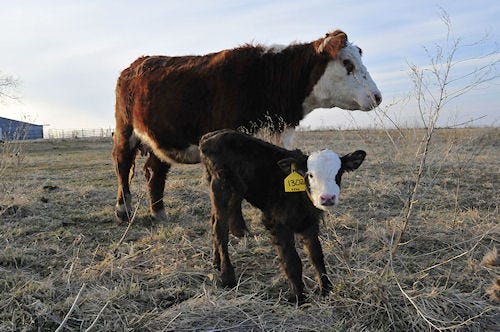December 21, 2011

Many Missouri cow-calf producers use the alphabet code for the year of birth of their calves. If you have purebred cattle, most beef breed associations require them as part of an animal's registration number.
The letter code for 2012 is Z, and then in 2013, it will start back at A, according to Eldon Cole, University of Missouri Extension livestock specialist, Mt. Vernon.
"As I work with farmers and their identification systems I'm surprised at how many calves are tagged with the basic 1, 2, 3, 4 etc. numbers," Cole says. "Each animal needs a unique number for long-term ID; otherwise, if you keep heifers, you either have to re-number them when they go in the herd or try to remember

Customize Your Ear Tag ID System
was that #6 the 2009 or the 2011 born #6. I realize in small herds you can keep track, but as numbers increase, the unique number system become more valuable."
Cole is frequently asked by beef producers about the most readable color combinations for tags. "Without a doubt, black numbers on yellow tags stands out best," he says. "Many use tag color to designate the sire or even year calves are born. This sounds good, but readability of the tag can compromise the benefits."
To designate sire, devise a simple alphabet or numerical code to print on the front or back of the tag. Cole knows some producer who will tag the bull calves in one ear and the heifers in the other. This helps when you're sorting for sex, unless you've mistakenly tagged a calf in the wrong ear which does happen.
The big question usually is which tag stays in the best? "I'd say there are differences in tag retention from farm-to-farm," Cole notes. "The biggest cause of lost tags is poor placement in the ear. As a rule, the tags should be placed higher and closer to the head than many folks do. They should also be easy to see -- you need to periodically clip the hair from around the tag when you have the cows in the chute."
Another frequently seen problem is the battle for ear space. Cole says he was working with the MU Extension bull soundness clinics last fall and one older bull came through with six ear tag holes in one ear. "Most of them were likely fly tag holes," he notes. "For good record keeping on cows, I encourage you to tag your cattle with a tag in each ear. They'll lose a tag every now and then, but seldom lose both before you can establish who they are.
"Tags are not the perfect ID system, but every herd needs some method of keeping track of who's a profit maker and who's a profit taker," Cole adds. "Some producers prefer a hot or freeze brand for identification. Both are effective and if you do a good job, they're there forever and you don't have a $1 or more tag cost."
Tag your pastures, too
If you have developed several pastures or paddocks for management intensive grazing and would like to keep better track, "tag" each of them with an "ear" tag. Simply number your pastures and put the corresponding ear tag number on a post or gate so everyone who might be moving cattle can keep track of the pastures that the cattle come from or will go to. It's also a good idea to write the turn-in date on the back of the tag and animal count in each pasture or paddock.
Source: MU Extension
You May Also Like




